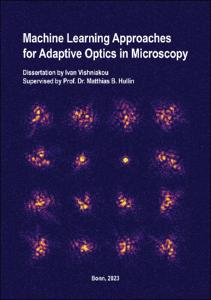Vishniakou, Ivan: Machine learning approaches for adaptive optics in microscopy. - Bonn, 2023. - Dissertation, Rheinische Friedrich-Wilhelms-Universität Bonn.
Online-Ausgabe in bonndoc: https://nbn-resolving.org/urn:nbn:de:hbz:5-70762
Online-Ausgabe in bonndoc: https://nbn-resolving.org/urn:nbn:de:hbz:5-70762
@phdthesis{handle:20.500.11811/10822,
urn: https://nbn-resolving.org/urn:nbn:de:hbz:5-70762,
author = {{Ivan Vishniakou}},
title = {Machine learning approaches for adaptive optics in microscopy},
school = {Rheinische Friedrich-Wilhelms-Universität Bonn},
year = 2023,
month = may,
note = {Microscopic imaging is an essential tool for science. For instruments that operate close to the physically possible diffraction limit, a main remaining challenge are aberrating operating conditions. For microscopy, such conditions are routinely encountered for example in biology, where tissue samples induce increasingly stronger aberrations with increasing imaging depth. Similar problems are also encountered in astronomy where atmospheric turbulences hinder ground-based telescopes.
Adaptive optics – a method originally developed for earthbound telescopes – can be applied in microscopy to compensate for sample-induced aberrations. However, a major challenge for microscopy lies in measuring aberrations and therefore in finding wavefront corrections.
This thesis presents machine learning methods developed for aberration sensing and correction compatible with two-photon laser scanning microscopy. A first approach uses deep learning with labelled datasets of focus images and corresponding aberrations. These datasets were created using a spatial light modulator, and were then used to train neural networks for detecting the aberrations in the system. A second approach for adaptive optics was developed that uses optimization of a forward model to infer the unknown aberration. This technique relies on a mathematical model of image formation, including initially unknown aberration parameters. The actual aberrated system was probed by controlled light modulations and the computational model was matched to observations using gradient-based optimization, which was efficiently implemented using a machine learning framework with automatic differentiation and GPU-accelerated computing. This method was first demonstrated in a proof-of-principle experiment in two different configurations with scattered light and then using fluorescence in a two-photon laser scanning microscope.},
url = {https://hdl.handle.net/20.500.11811/10822}
}
urn: https://nbn-resolving.org/urn:nbn:de:hbz:5-70762,
author = {{Ivan Vishniakou}},
title = {Machine learning approaches for adaptive optics in microscopy},
school = {Rheinische Friedrich-Wilhelms-Universität Bonn},
year = 2023,
month = may,
note = {Microscopic imaging is an essential tool for science. For instruments that operate close to the physically possible diffraction limit, a main remaining challenge are aberrating operating conditions. For microscopy, such conditions are routinely encountered for example in biology, where tissue samples induce increasingly stronger aberrations with increasing imaging depth. Similar problems are also encountered in astronomy where atmospheric turbulences hinder ground-based telescopes.
Adaptive optics – a method originally developed for earthbound telescopes – can be applied in microscopy to compensate for sample-induced aberrations. However, a major challenge for microscopy lies in measuring aberrations and therefore in finding wavefront corrections.
This thesis presents machine learning methods developed for aberration sensing and correction compatible with two-photon laser scanning microscopy. A first approach uses deep learning with labelled datasets of focus images and corresponding aberrations. These datasets were created using a spatial light modulator, and were then used to train neural networks for detecting the aberrations in the system. A second approach for adaptive optics was developed that uses optimization of a forward model to infer the unknown aberration. This technique relies on a mathematical model of image formation, including initially unknown aberration parameters. The actual aberrated system was probed by controlled light modulations and the computational model was matched to observations using gradient-based optimization, which was efficiently implemented using a machine learning framework with automatic differentiation and GPU-accelerated computing. This method was first demonstrated in a proof-of-principle experiment in two different configurations with scattered light and then using fluorescence in a two-photon laser scanning microscope.},
url = {https://hdl.handle.net/20.500.11811/10822}
}






